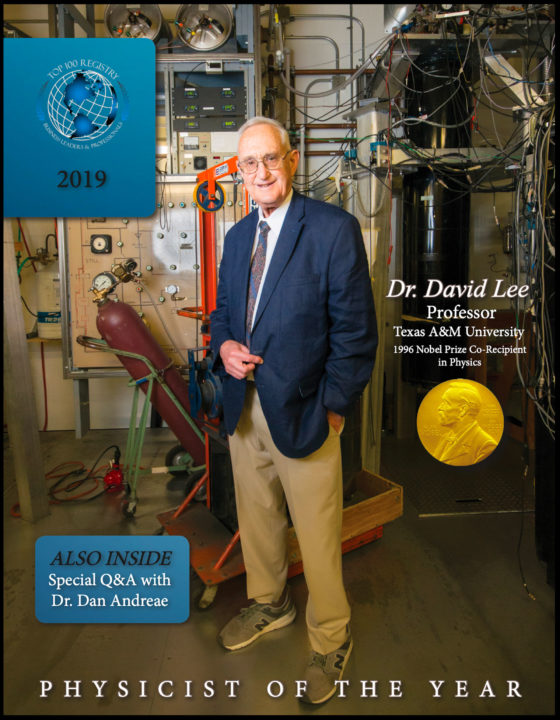 The Top 100 Registry
The Top 100 Registry —
David Lee is an American Physicist and Professor at Texas A&M University, located in College Station, Texas. Utilizing six decades of experience, Dr. Lee is a prominent physics educator who has been a distinguished professor of physics at Texas A&M University in College Station since 2009, having previously been a James Gilbert White distinguished professor of the physical sciences at Cornell University in Ithaca, New York, from 1999 to 2009. Prior to these illustrious roles, he served Cornell University in multiple capacities, including instructor of physics, associate professor of physics and professor of physics between January 1959 and 1999. Alongside his primary endeavors, he was a visiting professor at several universities, including Peking University in Beijing, China, the University of California, San Diego in La Jolla, and the University of Florida in Gainesville. Likewise, Dr. Lee was a visiting scientist at the Brookhaven National Laboratory in the late 1960s and chair municipale of Joseph Fourier University in Grenoble, France in the early 1990s.
Dr. Lee is most renowned for his co-discovery of superfluid helium-3 along with Douglas Osheroff and the late Robert Richardson in 1972. This work also involved one of the first applications of magnetic resonance imaging to a physics experiment before it became an important medical tool. In another series of experiments, he discovered spin waves in spin polarized hydrogen gas. He also discovered a density maximum in liquid helium-3 and made extensive measurements of the phase diagram of liquid and solid helium-3, helium-4 mixtures. His work on superconducting tunneling in cadmium-aluminum junctions was one of the first studies of this phenomenon below the temperature of one Kelvin degree above absolute zero. More recently he observed collective sound modes in superfluid helium-3 which obeyed the Nambu identity and is analogous to the Higgs Phenomenon in elementary particle physics. He is now actively engaged in studies of atomic free radicals trapped in low temperature matrices including spin polarized hydrogen atoms embedded in the films of molecular hydrogen. He is grateful to all of his co-workers, including the 33 Ph.D. graduate students he mentored, for their essential roles in all of this work.
 David Lee (Photo courtesy of David Lee)
David Lee (Photo courtesy of David Lee)To prepare for his career, Dr. Lee pursued formal education at Harvard University in Cambridge, MA, where he earned a Bachelor of Arts in 1952. Upon returning from military service in the U.S. Army, he earned a Master of Science from the University of Connecticut in Storrs in 1955 and a Doctor of Philosophy from Yale University in New Haven, Connecticut, in 1959.
Articles contributed to professional journals appeared in The Physical Review, Physical Review Letters, Nature, Physics Scripta, Proceedings of the National Academy of Science, Journal of Low Temperature Physics, Journal of Physical Chemistry and the Review of Scientific Instruments.
As a testament to his success, Dr. Lee has been recognized with myriad accolades. He was a co-recipient of the Nobel Prize for physics in 1996 for the discovery of superfluid helium-3, jointly with his co-workers. He considers this to be a highlight of his career. He received the Wilbur Cross Medal from Yale University in 1998. He also was awarded along with his superfluid helium-3 co-workers, the Sir Francis Simon Memorial Prize from the (British) Institute of Physics in 1976 and the Oliver Buckley Prize of American Physical Society for the Promotion of Sciences, he additionally received fellowships from the Guggenheim Foundation for 1966-1967 and again for 1974-1975. Dr. Lee has been highlighted in multiple editions of Who’s Who in 20th Century. In his spare time, David enjoys jogging, hiking, and fishing.
Contact Details:
David Lee,
dmlee@physics.tamu.edu
This article first appeared on
The Top 100 Registry Publication (2019).

